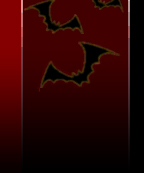|
Castlevania: Symphony of the Night (1997)

Castlevania: Symphony of the Night is certainly a departure from most of its predecessors, even though the Castlevanias that came afterward sought to emulate its style. Yet it remains to this day the high point of the series.
Taking a page out of the Metroid series (and its long lost ancestor, Simon's Quest), Symphony of the Night ditches the traditional side-scrolling routine in favor of a non-linear adventure, with some RPG elements tossed in.
The game begins with you taking control of Richter Belmont, as he fights Dracula at the end of Dracula X (the good PC Engine one, not the iffy SNES one.) Once you defeat Draccy, the real storyline kicks in - four years later, Richter mysteriously disappears and Castlevania materializes out of fog. Maria Renard, now fully grown, begins a search for her old compatriot. Meanwhile, Alucard, the son of Dracula who sealed himself away after Castlevania 3, had awoken to fight the forces of evil once again, and investigate the mysteries of his father's castle.
Suffice to say, Castlevania: Symphony of the Night is one of the best videogames ever made. Rather than structure the rest of review like normal, I feel it'd be a better idea to have a fanboy-ish list why Symphony rulez.
(5). The 2D graphics are amazing. Alucard is one of the most well animated sprite heros in history. Some of the lesser enemies are dragged straight from previous Castlevania titles, but almost all of them have unique attacks and death animations. And the bosses. Oh lord, the bosses. When you see some of these towering, detailed, twisted monstrosities, you'll stand up and applaud Konami for their achievement (well, maybe not.) Suffice to say, this game still looks pretty.
(4) The soundtrack. Symphony of the Night has some of the most varied music styles heard in a game - you'll hear the typical Gothic themed Castlevania music, hard rock, jazz fusion, techno, classical, orchestral, piano - and it's all gorgeous. Unfortunately, the English voice acting isn't quite up to par - while Alucard's voice is pretty good, the rest of the cast fails miserably, and most of the dialogue is turned into a laughing matter as a result.
(3) Alucard. He is the proverbial Man. While the storyline is certainly more involved than the typical Castlevania game, it's pretty predictable. Alucard, with his incredibly cool outfit, legions of weapons, vampire angst and magical spells simply defines the epitomy of video game protagonists.
(2) Gameplay. Castlevania's always been known for stiff, difficult to control characters. While the series got better over time, Symphony of the Night has such incredibly smooth controls that it's a pure joy to control Alucard.
(1) Depth and replay value. All of the above help make Symphony of the Night an absolutely superb game. But it's the extraordinary amount of weapons and secrets that makes this game seem fresh even after being out for so many years, and is why this title outdoes its Game Boy Advance successor, Harmony of Dissonance. Sure, there's the usual hidden passageways and such that diehard fans will want to explore so they can get full map completion and obtain the best ending. But the amount of weapons and attacks found the game means that you'll be spending a lot of time hacking through the corridors of Dracula's castle if you really want to find the holy Crissagraem, the vacuum blade of incredible power, or the flying sword Runeblade, or innumerable amount of shields, each with a hidden power unlocked with the Shield Rod.
It's this attention to details that makes the game stand out so much. And even once you've finished playing with Alucard, you can take Richter through the castle for a more old-school type exploration.
So there you have it. The only thing that might possibly be wrong with Symphony of the Night is the difficulty...or rather, the absence of it. While the beginning parts of the game might pose a challenge to those unaquainted with Castlevania, once you power-up Alucard, the game is a breeze. It's a bit of a shame to see some of the incredible bosses later in the game, and being able to beat them without exerting any semblance of effort. Still, given the tremendous amount of things that Symphony does right, it's hard to fault it just for this.
Being the ultimate Castlevania game and all means that the game's become something of a rarity, even though Sony re-released it under the Greatest Hits label at one point, and still fetches high prices on the market. And for good reason. If you don't own this game yet, do anything and everything in your power to obtain it.
Symphony of the Night Artwork

Back to Top
Castlevania Games - Castlevania: Symphony of the Night
|



